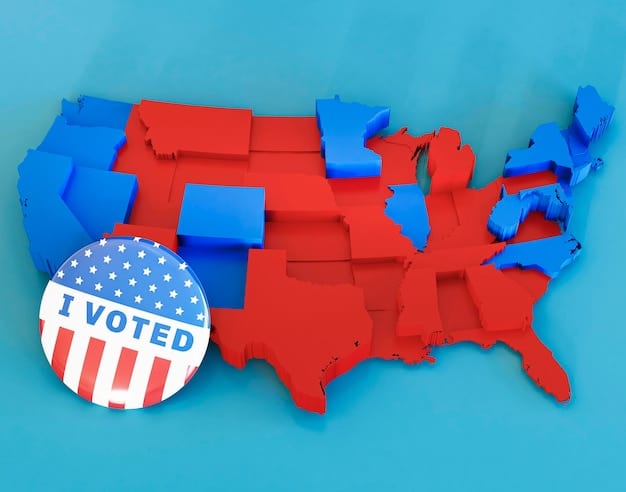Community Voices: Protecting Voting Rights in 2025

Community Voices and the Fight for Voting Rights: Protecting Access to the Ballot Box in 2025 focuses on the crucial role communities play in safeguarding fair elections, addressing voter suppression, and ensuring every citizen’s voice is heard through policy advocacy and grassroots movements.
The integrity of democratic processes hinges on the ability of every citizen to participate freely and fairly in elections. Understanding the nuances of Community Voices and the Fight for Voting Rights: Protecting Access to the Ballot Box in 2025 is more critical than ever as we approach upcoming elections and navigate ongoing challenges to voter access.
The Landscape of Voting Rights in the US
Voting rights in the United States have been a contentious issue throughout history, with various groups facing systemic barriers to participation. Understanding the historical context and current challenges is essential for addressing modern threats to voter access. This section explores the evolution of voting rights, landmark legislation, and the ongoing struggle to ensure every citizen can exercise their right to vote.
Historical Context of Voting Rights
The fight for voting rights in the US is marked by significant milestones, from the abolition of slavery and the passage of the 15th Amendment to the Civil Rights Movement. However, these advancements were often met with resistance in the form of poll taxes, literacy tests, and other discriminatory practices.
Landmark Legislation and Its Impact
Key legislative victories, such as the Voting Rights Act of 1965, aimed to dismantle discriminatory barriers and protect the voting rights of minority groups. However, subsequent Supreme Court decisions and legislative actions have weakened these protections, leading to new challenges.

- 15th Amendment: Granted African American men the right to vote (1870).
- Voting Rights Act of 1965: Prohibited discriminatory voting practices.
- Shelby County v. Holder (2013): Struck down key provisions of the Voting Rights Act.
Despite progress, systematic inequalities persist, creating a patchwork of accessibility that disenfranchises many potential voters.
In conclusion, the landscape of voting rights in the US remains complex and dynamic, requiring constant vigilance and advocacy to ensure fair and equal access for all citizens.
Modern Challenges to Voter Access
Despite landmark legislation aimed at protecting voting rights, numerous challenges persist that hinder voter access for marginalized communities. Voter ID laws, gerrymandering, and reduced polling locations disproportionately affect minority groups, students, and low-income individuals. Recognizing these barriers is crucial for developing strategies to promote equitable participation in elections.
Voter ID Laws and Their Impact
Voter ID laws require individuals to present specific forms of identification at polling places, which can disenfranchise those who lack the necessary documentation or face difficulties obtaining it. These laws often disproportionately affect minority voters, students, and the elderly.
Gerrymandering and Its Effects on Representation
Gerrymandering involves manipulating electoral district boundaries to favor one political party or group, diluting the voting power of specific communities. This practice can lead to skewed representation and reduced accountability of elected officials.
- Strict ID Requirements: Disproportionately affect minority voters.
- Precinct Closures: Reduce access for rural and low-income voters.
- Gerrymandering: Skews representation and reduces accountability.
The Role of Technology to Combat these Challenges
Many modern challenges can be combatted by incorporating technology such as AI for candidate searching along with easily accessible polling locations online. AI can also be used to increase voter turn out by suggesting candidates based on demographic and geolocation.
Navigating policy changes to increase voter turnout can be difficult however there are many resources available such as the ACLU.
Ultimately, the modern challenges to voter access require comprehensive strategies that address systemic barriers and promote equitable participation in elections. Community empowerment and advocacy play a vital role in ensuring that every eligible citizen can exercise their right to vote.

The Role of Community Voices
Community organizations and grassroots movements are at the forefront of the fight for voting rights, playing a crucial role in voter education, mobilization, and advocacy. By empowering marginalized communities and amplifying their voices, these groups work to ensure fair and equitable access to the ballot box. In this section, we examine the various ways community voices are making a difference in the fight for voting rights.
Grassroots Movements and Voter Mobilization
Grassroots movements are essential for mobilizing voters, particularly in marginalized communities. Through door-to-door canvassing, phone banking, and community events, these movements engage individuals and encourage them to participate in the electoral process.
Community Organizations and Voter Education
Community organizations provide valuable voter education resources, informing individuals about registration requirements, polling locations, and candidate information. By demystifying the voting process, these organizations empower individuals to make informed decisions.
By bringing people together and educating the public, community outreach organizations can make a significant impact on voter turnout and civic engagement.
- Empowerment: Equipping people with knowledge and resources.
- Advocacy: Fighting for policy changes that protect voting rights.
- Mobilization: Encouraging participation in the electoral process.
In conclusion, community voices are vital for promoting fair and equitable access to the ballot box. By empowering marginalized communities and advocating for policy changes, these groups work to ensure that every citizen can exercise their right to vote.
Policy Advocacy and Legal Challenges
Effective policy advocacy and strategic legal challenges are essential tools in the fight for voting rights. Advocates work to influence legislation at the local, state, and federal levels, pushing for reforms that expand voter access and protect against discriminatory practices. Legal challenges target restrictive voting laws and practices, seeking to uphold the constitutional rights of all citizens.
Legislative Reforms and Advocacy Efforts
Advocates push for legislative reforms that expand voter access, such as automatic voter registration, same-day registration, and expanded early voting options. These reforms make it easier for individuals to register and cast their ballots, increasing voter turnout.
Legal Challenges to Restrictive Voting Laws
Legal challenges target restrictive voting laws and practices, such as voter ID laws and gerrymandering. Lawsuits are filed to challenge these laws, arguing that they violate the constitutional rights of voters.
With the help of effective policy, many individuals can exercise their right to vote and have their voices heard.
- Lobbying: Engaging with policymakers to advocate for voting rights reforms.
- Litigation: Challenging restrictive voting laws in court.
- Public Awareness Campaigns: Educating the public about voting rights issues.
Effective policy advocacy and strategic legal challenges are essential for protecting voting rights and ensuring fair elections. These efforts require collaboration among various stakeholders, including community organizations, legal advocates, and elected officials.
Technology and Innovation in Voting Access
Technology and innovation offer new opportunities to enhance voter access and improve the efficiency and security of elections. Online voter registration, electronic poll books, and accessible voting machines can streamline the voting process and make it more inclusive for individuals with disabilities. This section explores the potential of technology to transform voting access.
Online Voter Registration Systems
Online voter registration systems make it easier for individuals to register to vote, as they can complete the process from the comfort of their own homes. These systems also reduce the risk of errors and fraud, as information is entered directly into the voter registration database.
Accessible Voting Machines for People with Disabilities
Accessible voting machines provide individuals with disabilities the opportunity to vote independently and privately. These machines include features such as audio ballots, tactile keypads, and sip-and-puff devices.
From online resources to electronic guides, technology can help improve voting access.
- Efficiency: Streamlining the voting process and reducing wait times.
- Accessibility: Making voting more inclusive for people with disabilities.
- Security: Protecting the integrity of elections and preventing fraud.
Technology and innovation have the potential to transform voter access and improve the efficiency and security of elections. However, it is important to address concerns about cybersecurity and data privacy and ensure that technology is implemented in a way that promotes equity and fairness.
Ensuring Fair Elections in 2025
As we look ahead to the 2025 elections, it is crucial to identify and address potential threats to voter access. Ongoing voter suppression efforts, cybersecurity risks, and disinformation campaigns pose significant challenges to ensuring fair elections. By understanding these threats and implementing proactive measures, we can safeguard the integrity of the electoral process.
Combating Voter Suppression Efforts
Voter suppression efforts, such as restrictive voter ID laws and reduced polling locations, disproportionately affect minority groups and low-income individuals. To combat these efforts, it is essential to advocate for policies that expand voter access and protect against discriminatory practices.
Addressing Cybersecurity Risks and Election Interference
Cybersecurity risks and election interference pose significant threats to the integrity of elections. To address these risks, it is essential to invest in secure voting systems, conduct regular audits, and implement robust cybersecurity protocols.
- Education: Informing voters about their rights and the importance of participating in elections.
- Advocacy: Pushing for policies that protect voter access and combat suppression efforts.
- Security: Investing in secure voting systems and cybersecurity protocols.
Ensuring fair elections in 2025 requires a comprehensive approach that addresses potential threats to voter access and protects the integrity of the electoral process.
| Key Point | Brief Description |
|---|---|
| 🗳️ Voter ID Laws | Can disenfranchise those lacking proper identification. |
| 🗺️ Gerrymandering | Manipulates district boundaries to favor a party. |
| 📢 Community Advocacy | Empowers voices for fair access. |
| 🔒 Tech & Innovation | Enhances access if implemented equitably. |
Frequently Asked Questions
▼
Community voices play a vital role in advocating for fair and equitable voting access, especially for marginalized groups. They help mobilize voters, educate communities, and push for policy changes that protect voting rights at the local and national level.
▼
Voter ID laws can disproportionately affect minority, low-income, and elderly voters who may lack the required identification or face challenges in obtaining it. This can lead to lower voter turnout and disenfranchisement in these communities.
▼
Technology can both expand and restrict voter access. Online voter registration and accessible voting machines can enhance access, while cybersecurity threats and disinformation campaigns can undermine election integrity and discourage participation.
▼
Community organizations can combat voter suppression through education, mobilization, and advocacy. They provide resources on voter registration and rights, organize voter drives, and lobby for policies that protect voting access and promote fair elections.
▼
Key policy changes include automatic voter registration, same-day registration, expanded early voting options, and independent redistricting commissions to combat gerrymandering. Strengthening cybersecurity measures is also crucial for protecting election integrity.
Conclusion
Protecting access to the ballot box in 2025 demands a multifaceted approach, synergizing community empowerment, policy advocacy, and technological innovation. As challenges to voter access persist, the unwavering commitment of community voices and strategic legislative action remains paramount in safeguarding democracy for all citizens.





